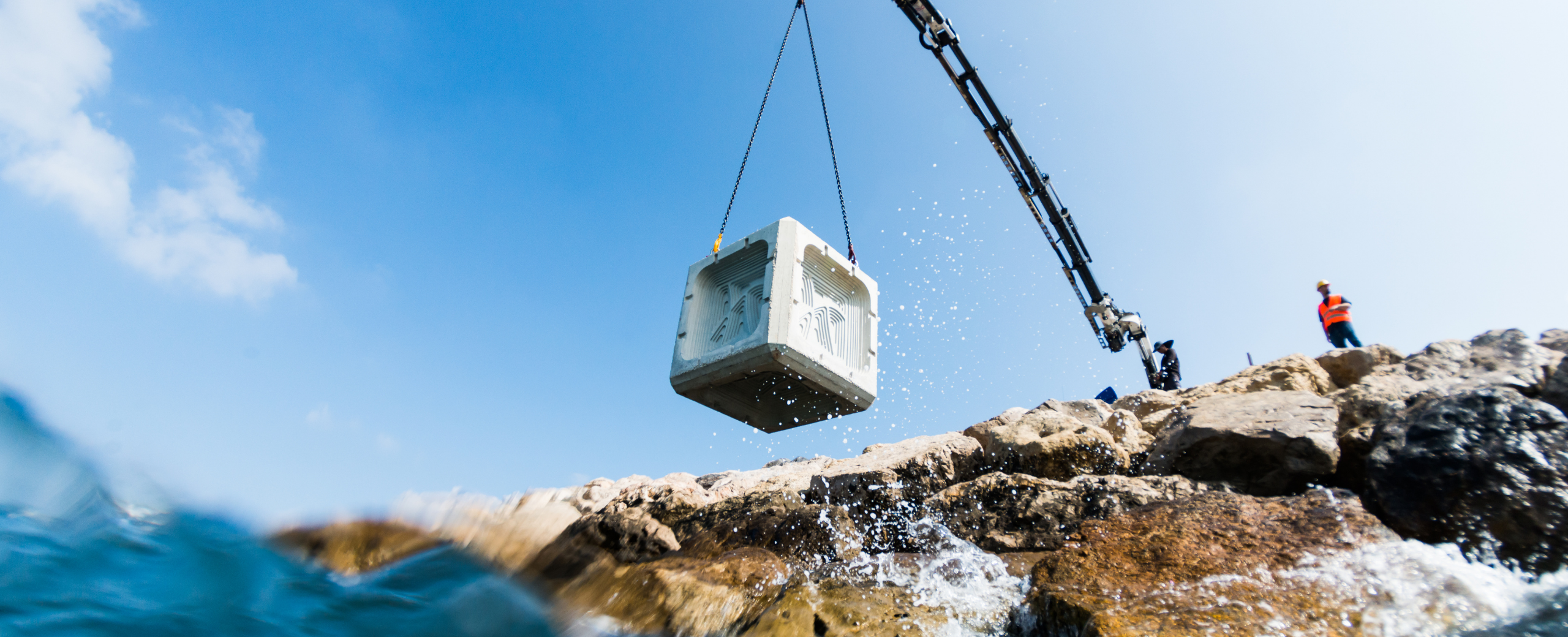Study Duration: 2013 – 2016
This case study is for landscape architects, engineers, and asset owners who would like to deepen their knowledge of the environmental performance differences between ECOncrete®’s solutions and traditional concrete. While ECOncrete’s technology can be applied to any marine concrete, this installation was a pilot project to study the technology’s ecological performance in breakwater armoring units. Since this pilot, ECOncrete’s technology package has been used to develop a variety of armoring units for projects ranging from offshore applications to urban shoreline protection measures.
Problem & Solution
In our marine environment, we build 70% of infrastructures from concrete. While it’s strong and versatile, this material is detrimental to life underwater, leaving our waterfront assets, ecosystems, and communities vulnerable to a changing climate. Concrete’s underwater impacts are a consequence of three design features: a toxic chemical composition and smooth surface textures discourage marine life from growing on the structure, resulting in less local biodiversity and more invasive species. Flat-plane designs provide little shelter and few growth points for marine biology, resulting in infrastructure that stays lifeless for decades. These design failures combine to create infrastructure with high environmental penalty costs, higher maintenance needs, and lower resilience.
ECOncrete resolves these three features with a patented admix, texture agents, and molds proven to improve the structural and ecological performance of concrete. The admixture seals and strengthens concrete by up to 10%, while a combination of texture agents, liners, and molds bring high surface complexity and design features. ECOncrete’s technology enables a rich layer of marine life, like oysters, tubeworms, and corals to grow, thereby generating an active carbon sink and biodiverse ecosystem, while creating structural benefits, such as greater strength and durability. The technology meets industry standards, is flexibly sourced, and can be easily integrated into any concrete marine infrastructure.
Project Details
The breakwater at the Port of Haifa was constructed with traditional cube-shaped Portland cement armor units, called antifers. ECOncrete applied its 3-part design strategy to engineer an armoring unit that would perform as an ecologically friendly and structurally sound alternative. 15 ECOncrete concrete armor units were installed among the traditional cement antifers to compare their ecological performance.
Project Monitoring
The two-year study (2013-2015) compared ECOncrete’s armoring units to the port’s existing antifer units. At the end of the monitoring period, ECOncrete’s armoring units were covered in double the species richness and biodiversity than the Portland cement antifer units. The biodiverse marine life present on ECOncrete’s units included various species of oysters, sponges, sessile worms like Sabellidae and Serpulidae, tunicates, bryozoans, and coralline algae. Throughout the monitoring period, these ecological communities contributed to water filtration and habitat complexity, and attracted native fish species. ECOncrete’s armoring units contained higher fish diversity than the antifer units, as well as post-larval stages of transient fish (Sparidae). During the monitoring period, as many as two-thirds of the species on ECOncrete’s armoring units were local, with the rest being invasive. In contrast, invasive species were significantly more dominant on the antifer units by the end of monitoring.
Of the calcitic organisms growing on the units, species like oysters, corals, and barnacles cemented their calcitic skeletons onto the concrete. These creatures create an additional layer of protection from hydrodynamic forces and chloride penetration, thus leading to reduced maintenance costs and a more durable armoring unit. This protective layer also has an additional benefit: when the organisms create their shells, they draw carbon dioxide from the water, creating an active carbon sink. When growing on a one-kilometer-long by seven-meter-high seawall, for example, the calcitic organisms on ECOncrete’s technology can generate a carbon sink equivalent to 100 trees every year.
